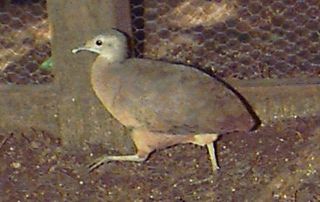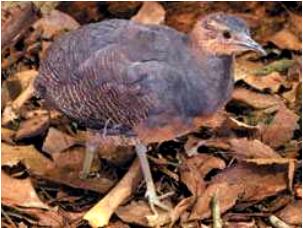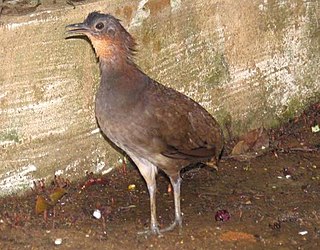
The little tinamou is a species of tinamou. It is found in Central and South America, as well as on the Caribbean island of Trinidad.

The brown tinamou is a brownish ground bird found in humid lowland and montane forest in tropical and subtropical South America.

The yellow-legged tinamou is a species of tinamou found in wooded and shrubby habitats in tropical and subtropical eastern Brazil. This superficially quail-like bird has a grey-brown plumage and two easily separated subspecies. It has declined due to human activities, and is therefore listed as Near Threatened by the IUCN.

The variegated tinamou a type of tinamou commonly found in moist forest lowlands in subtropical and tropical regions of northern South America.

Crypturellus is a genus of tinamous containing mostly forest species. However, there are the odd few that are grassland or steppe tinamous. The genus contains 21 species.

The red-legged tinamou or red-footed tinamou, is a ground-dwelling bird found in the tropics and lower subtropics of northern South America.

The tepui tinamou is a type of ground bird found in montane moist forest on tepuis, in southeastern Venezuela.

The undulated tinamou is a species of ground bird found in a wide range of wooded habitats in eastern and northern South America.

The pale-browed tinamou is a type of tinamou found in tropical dry forests in Peru and Ecuador.

The Brazilian tinamou is a type of tinamou found in tropical moist lowland forest in regions of Amazonian South America.

The thicket tinamou or rufescent tinamou is a type of tinamou commonly found in moist forests in subtropical and tropical central Mexico.

The slaty-breasted tinamou or Boucard's tinamou is a type of tinamou commonly found in lowland moist forests of Mexico and Central America.

The Choco tinamou or Chocó tinamou is a type of tinamou found in lowland forest and montane forest in subtropical and tropical regions of Colombia and Panama.

The rusty tinamou or short-billed tinamou is a type of tinamou commonly found in swamp forest in tropical regions of South America.

Bartlett's tinamou is a type of tinamou found in lowland forest in South America.

The small-billed tinamou is a type of Tinamou commonly found in dry savanna in Amazonian South America.

The barred tinamou is a type of tinamou commonly found in lowland moist forest in subtropical and tropical regions of northern South America.

The Tataupa tinamou is a type of tinamou commonly found in dry forest in subtropical and tropical regions in southeastern South America.

Taczanowski's tinamou is a type of ground bird found in the eastern Andes in Peru in the Junín, Cuzco, Apurímac, Ayacucho, and Puno Regions.

The brushland tinamou is a type of tinamou commonly found in high-altitude dry shrubland in subtropical and tropical regions of southern South America.




















